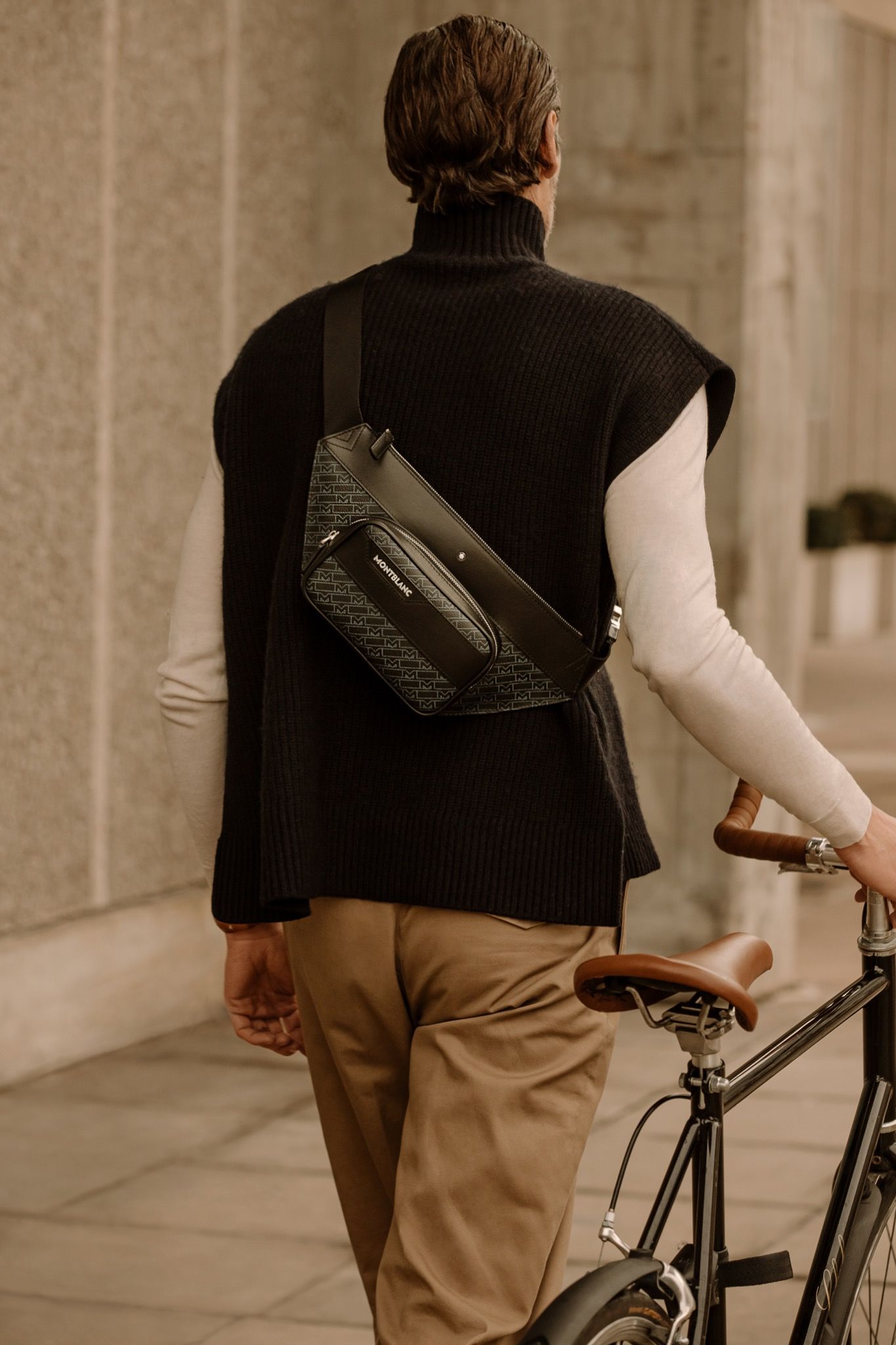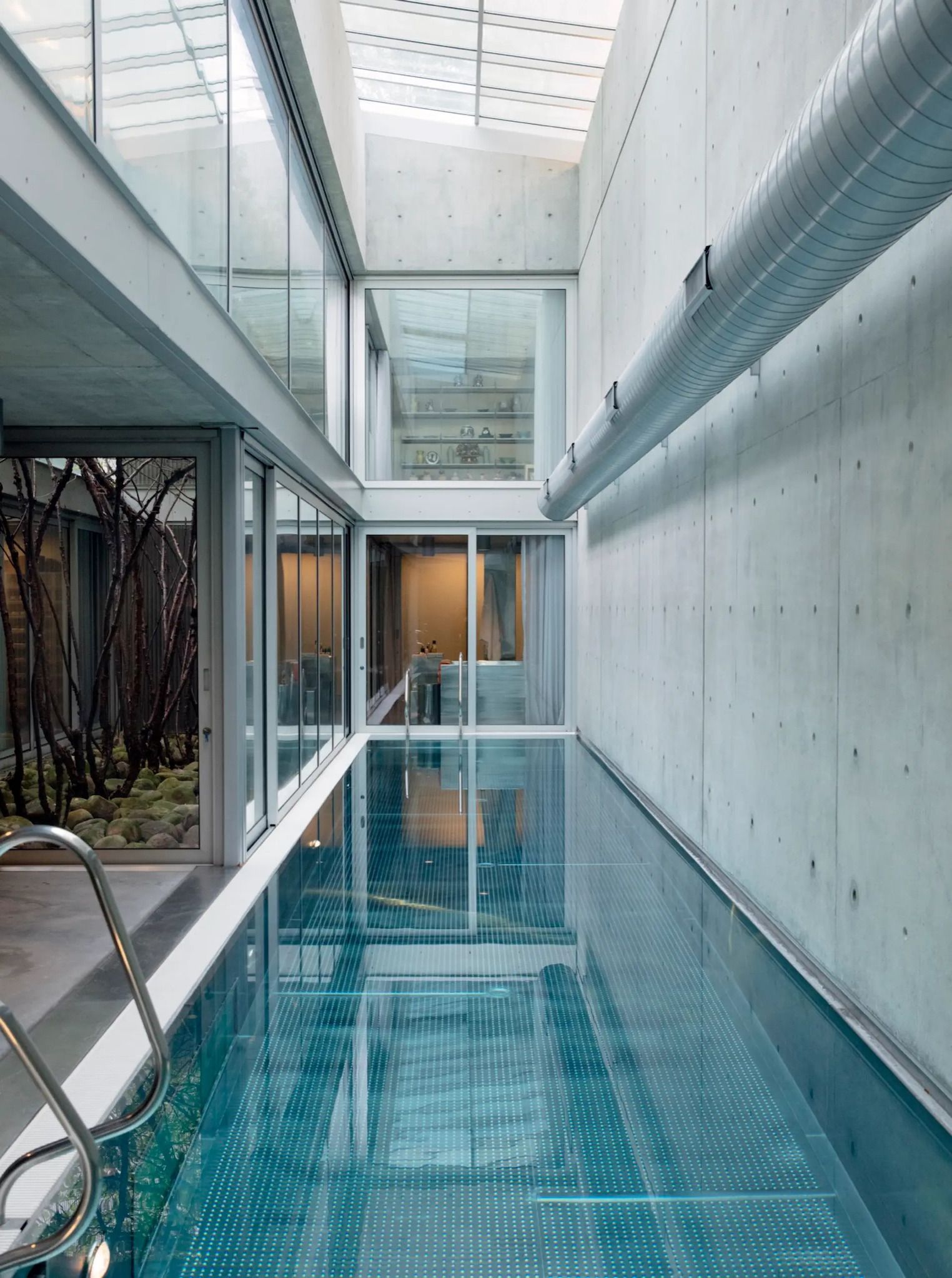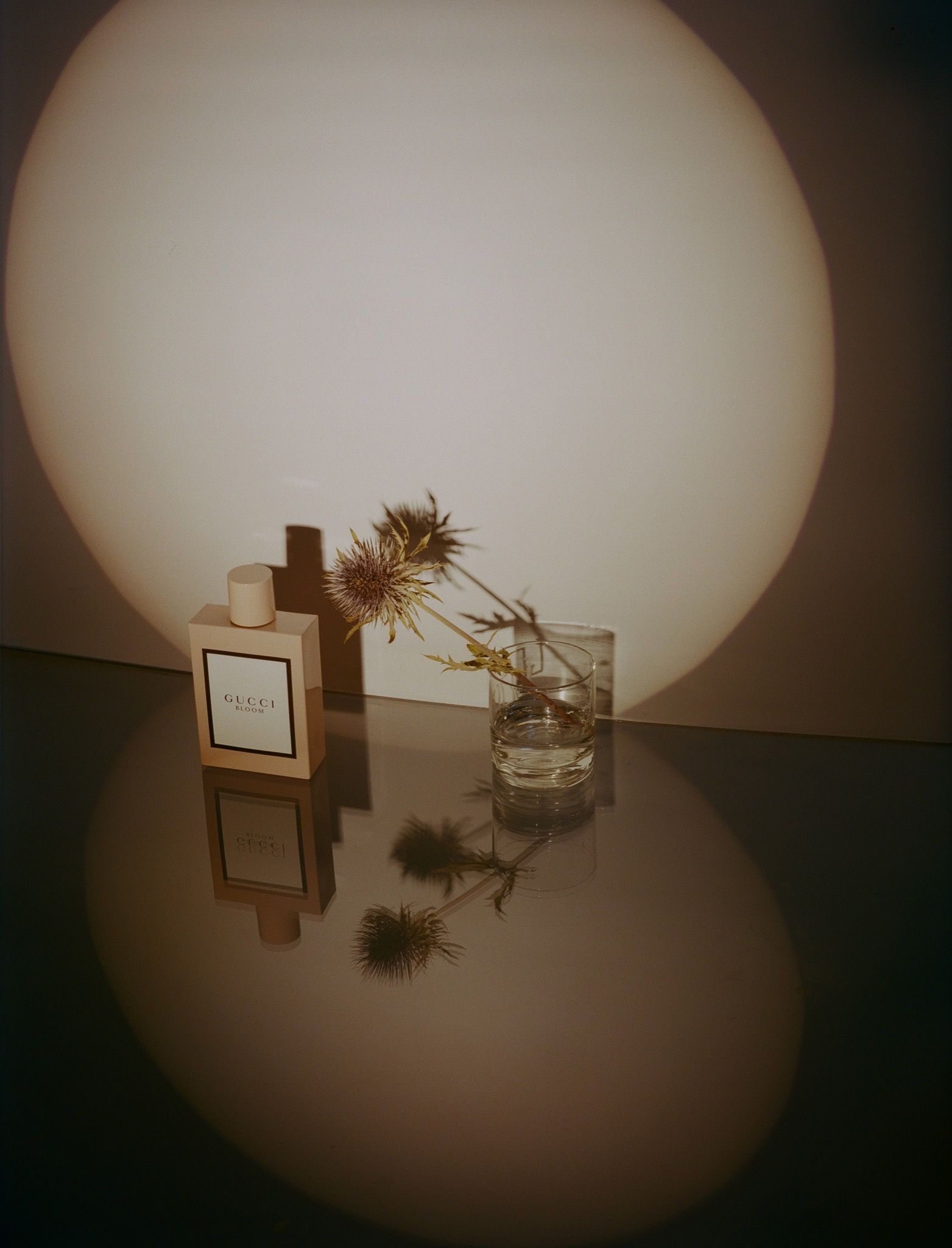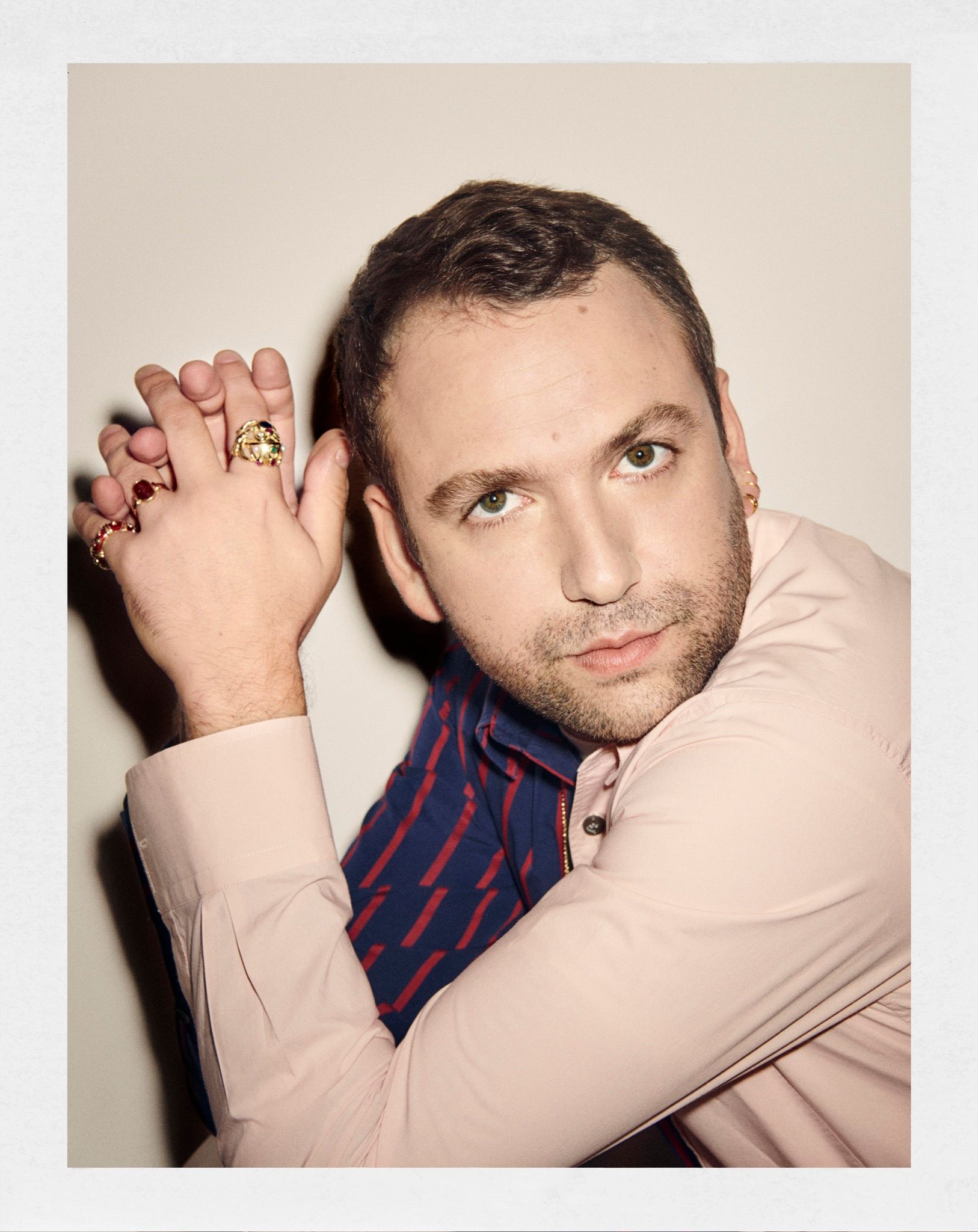M_GRAM 4810: “Product in Movement”
|Victoria Camblin
Alongside the release of the MONTBLANC M_4810 collection – and amid shifting global paradigms of travel and luxury – creative director ZAIM KAMAL talks mobility, heritage, and the meaning of the monogram.

Montblanc has always had a knack for visualizing aspiration and agility: for more than a century, its best known trademark has been a stylized view of the six-pointed snowcap for which it is named. Even the German brand’s first initial mimics the peaks of the 4810-meter tall mountain. Now, Montblanc presents a new “M”: an original, all-over logo treatment launched with the M_4810 collection of unisex leather goods designed for function in the contemporary landscape while taking stock of the label’s heritage.
Founded in 1906 by a Hamburg financier, a salesman, and a Berlin engineer, Montblanc began as a maker of pens – products that, at the time, were not only high-end but high-tech, responding to a new era of travel and communication. The brand expanded into watches, leather goods, and other tools that adapted to a luxury market increasingly “on the go,” enabled by industrial growth and globalized networks of trade. The signature “Meisterstuck” line of writing instruments debuted in the 1920s, and that is the era to which creative director ZAIM KAMAL and team returned for inspiration in the creation of Montblanc’s latest emblem. The resulting pattern reenergizes archival graphics for a 2021 monogram true to the brand’s history and message, but designed to apply to future of tools of messaging and movement. True to Montblanc’s technology-oriented tradition, its latest smartwatch and audio accessories have received the M_Gram 4810 treatment alongside backpacks, document carriers, and variously sized bags, from pouches to totes. “It is a question of how people want to interact, and how people want to use tools,” says Kamal of providing customers with solutions for analogue and digital tendencies – both of which were in play when 032c spoke to the designer (remotely, per the new custom).
Images: Josephine de la Baume and Richard Biedul wear M_4810 for Montblanc


Montblanc has always been completely bound up with ideas of travel – including the product line you are launching now. All of our travel habits have obviously changed, but how have your thinking and creative process evolved as a result? Are you expanding your idea of what it means to travel, or reconsidering how to connect to or convey a sense of the voyage despite being grounded?
We’ve all heard of these cruises to nowhere and flights to nowhere, where you get on the plane you fly out, sit there for six hours, and then land back in Sydney. So there is an appetite to travel, to leave the ground and go into the sky. When you go through airport security, and you might see somebody unpack and repack their bag with a slight gesture and think, “I have to remember that” – because it’s a movement that you can incorporate into your designs or into your concepts. The richness of this global culture that we were exposed to informed the way we saw the world, the way we gathered information, the way we researched, the way we understood how it functions. Now that this has been curbed, we have to think about how we interact, how we get that inspiration, in new ways. We have to rethink not just the idea of travel but the very idea of mobility – we have to ask, “how do we move?” Mobility can be twofold: you can have a mobility that is physical, and you can have a mobility that is digital, online, communicative. If you and I were sitting across from each other right now, you could read into the way I use my hands, my eyes – and the way you react, I could gauge that. Which is exactly what brings the richness of interaction: this idea of being able to look beyond the obvious, this idea of gesture, of flow, of “product in movement,” as I call it – be it a garment, an accessory, a shoe, anything. Now you have to communicate more meaningfully, with words and with writing, in ways that go beyond the physical exchange. We have to substitute that with deeper and richer forms of expression. And you have to be much more precise.
You are talking about communication and its various subtleties, and if I had to narrate the Montblanc brand story, it begins with a tool intended for precisely that: the fountain pen. It’s a tool that communicates in a very stylized, very personal way. Is that history coming in here, too?
As you mention, in the beginning Montblanc was very much about travel – and about the tools and the companions that we take with us when we travel. So different mobility means different tools. When I have a quick meeting in the city, I take my bike instead of taking public transportation, and I just take the necessities that I need for that moment. So what are the companions, what are the things that you need? How do you carry them? One thing that we’ve worked on a lot in the last months is what you carry close to your body, because those are the things that we take now. Rethinking the purpose of the piece, you realize you don’t need a 48-hour bag anymore. You need smaller pieces, which you bring with you in a different way. Maybe you wear them under a jacket, for extra security – so your computer bags are smaller and closer to you. Another important thing we saw in lockdown is that people are actually physically writing by hand a lot. When you’re on a Zoom call, you don’t really want to type at the same time. You have pen and paper, and you make your notes. If I look at my entire year, I can reconstruct every day that I have been working from home because I have handwritten pages with dates on them. So, the idea is that now not just communication but the recording and the filing of information is done differently. It’s not just left up to an email; it’s left up to personal notes to accompany certain things.
Right now actually I’m writing notes on the back of an envelope that a friend of mine used to send me a handwritten letter. I sense you’re somewhat optimistic about these developments?
I’m the eternal optimist. It’s one of my things. And there’s a lot of optimism here because people are rediscovering or reconnecting with the things that move them. Writing is something that makes you want to express yourself, something that will leave a mark, and it’s very poignant for us to feel like we can leave a mark. You say you’re making notes on the back of an envelope that a friend sent you with a handwritten letter, which has a double function: you’re recording a conversation for work, but at the same time you’re creating a new kind of emotionality that will accompany this meeting. We’re creating new links, connections that are secondary to the obvious. This is the beauty of it. People say, “I’m just sitting in front of a Zoom and looking at the screen all day.” Yes, we all are. But I have also drawn more in the last month than I had for years. So it is an amazing time to connect and to be aware and to seek a balance between the tactile, the digital, and the unknown.
“We give you a beautiful product that’s tactile, that’s functional, that is beautiful to behold, but we don’t make it special – you make it special. The personality comes from the wearer, the user.”

Speaking of rediscovery, a central part of the latest collection is a newly stylized monogram that refers to graphics from the 1920s found in the Montblanc archive. Of course, it’s a very classic thing that a creative director of a heritage brand has to go back and find ways to navigate the archive and also adapt it and make the product new. What were you drawn to, and why?
For a long while, I was looking at the various aspects of what a monogram is. Let’s put it this way: it’s an identification with a tribe, so to speak. You’re creating an alignment, expressing something. So this monogram needed to carry all the heritage, the values, the expression of the Maison of Montblanc. Approaching the archive, I knew that what I was looking for had to incorporate certain elements: it needed to have the elevation, it needed to have the perspective, it needed to incorporate the lettering and it needed to have a dynamic that also stands true in time. I came across a poster in the archive that had everything that I was hoping for: the right dynamics, the right graphics, the right interplay between positive and negative. Then we asked, “If there was a next step for this graphic, what would it be?” We created an animation of the movement we saw in the poster. And with this simple movie we found the lines, we found the growth, we found the points where we could play. That’s how the monogram was developed. We kept the spirit of the expression of the 20s, but we brought it into an illustrative expression of today, to create this link between the past, the present, and the future. Because a monogram is something that has to stay for a very long time – but you have to also build it so that it can be played with. It’s not a static pattern; it’s something that you can expand with colors, with materials, with different ways of looking at it – you’ll see it on canvas, then embossed, then printed on luggage, on different surfaces. It was a long process, a long time before we got the balance right.
A monogram is a massive commitment, in other words – and one that has to say everything it has to say in one instant.
Yes, it has to be immediate. When you look at the monogram, you have to recognize the Maison, you have to recognize the value, you have to recognize the archive, you have to recognize where it’s coming from, and it still has to have a newness and a freshness to it. Combining all this is what makes it amazing.
It is a cliché to ask about this but I am curious – I assume that the “Montblanc customer” has evolved over the years, in terms of what this archetype does for business or leisure?
Montblanc Maison has been operating since 1906 – but the customer is not 100 years old. By which I mean the customer has always changed; we have always spoken to a new customer. The world, even pre-COVID, has changed radically in the last five years. The frontiers of globality, the frontiers between genders, age, culture – all of this started becoming blurred. People were already redefining their purpose. And we needed to understand how these new clients work. How do they move? How do they live? After understanding that, you can start working together to create products that speak to them. That’s also why the monogram was born. We understood that these new clients want an identifier, something that shows they belong to Montblanc. But you cannot just slap a monogram on an existing piece. When my father for instance used to do business, Monday through Friday, he had a suit and a briefcase. Then Friday when he came home, the briefcase was put into his study, the suit went to be steamed and hung up, and he changed into his weekend clothes and switched to his weekend bags. This doesn’t happen anymore. When I was travelling, I would leave on a Monday morning with one bag and this one bag was my home for a week. It had my clothes, my work stuff, my entertainment – everything was incorporated. So the flexibility and the versatility of the product became very important. Because the bag that you take to the airport, the bag that you use in a business meeting, and the bag that you take to dinner – they all need to express different things while fulfilling a purpose. It was a mindset change, and this mindset change was actually very exciting. I think it has opened us up for the years to come.
“I’m the eternal optimist. It’s one of my things.”

How do you reconcile this universality while responding not just to distinct venues but to consumers’ needs to fulfill a personal expression?
We’re talking about a luxury product – which is already something that makes people feel special. But each person also has to connect with this product in his or her own way. That’s the important thing, that’s what makes the product a companion: its tactility, its expression, how you interact with it. So if I give you a bag, and I have the same bag, and we use it on a daily basis, my bag will be my bag and your bag will be your bag. If somebody in the evening exchanged them, I would know straight away that that’s not my bag. Because I have imprinted it. It’s similar to the immersive quality that you have with vinyl records. This is something I always try to explain to my design team: you buy two copies of a vinyl record and you play it 100 times and you let someone else play the other one, then listen to the records on a neutral deck, they will sound different – even though they have the same information on them. Why? Because how I laid the record down, how I lifted it, what songs I listened to more changes the materiality of the record itself. The emotionality and the personal touch and the personality lies not on the grooves but between the grooves. We give you a beautiful product that’s tactile, that’s functional, that is beautiful to behold, but we don’t make it special – you make it special. The personality comes from the wearer, the user.
Fountain pens are also like that, right? If someone else uses yours it might not work as well for them, or it might change the thickness of the line when they return it, because of the angle they write with or how much pressure they put as they write.
Montblanc makes instruments that allow the user to imprint, to leave their mark – be it the writing instrument, be it the watch, be it leather goods, that is the important part. This is number one of the two things that we installed in our product: tactility. And with tactility comes companionship. My writing instruments – I have two in particular that I have been using for years – those are mine. Yes, they have scratches, because I’ve dropped them. This is what makes things personal and what makes Montblanc special, because you create a bond with them. I was speaking earlier about creating links, emotional connections, and these links happen by iterative usage.
Of course, “user” has become a term that we associate with apps and mobile devices now – with the digital sphere. How is Montblanc, as a brand and in this particular product line, adapting to or reflecting upon new technology – not just in terms of the types of accessories you’re making, but also in terms of methods of production and the materials you choose?
This comes back to the question of “who?,” and to how the clients have evolved. Of course, the tools people are using have changed. If I was traveling and I made a sketch in my sketchbook, by hand, I would take my phone and photograph it and send it to the design team. They would work on it, send me a PDF, which I would print out, write comments on by hand, then photograph and send it back. So what we realized is that people are using analogue and digital together, in a very homogenized way. Some people use more analogue, some who use more digital, but it is not for the Maison to say, “This is the way to go.” It is for us to provide you with the tools that allow you to scale it in your own way. It is very often asked of me why we do the augmented paper, “what it is about this new tech?” But new technology is simply a new tool for people to use. In 1906, making a writing instrument that held its own ink in a tank in its body was so completely outrageous; it blew people’s minds. “These guys are crazy. How do they do it? The ink will fall out and it will ruin your clothes!” It’s about making an audacious decision based on an understanding of what the client will actually need and use going forward. That’s what has made Montblanc successful since the beginning, and why we have always managed to stay relevant through our product, because it is based on the idea of creating a tool that holistically fulfills daily needs of work, communication, exchange. So the move into new tech was a very logical step for us. Now the idea is taking the original craftsmanship and building it into the tech products.
Writing instruments like pens are technology. The tools have always evolved, but as they do, the basic means that we use to communicate – words and images, gesture and movement – are still there. I’ve always had a little bit of a pet peeve for this scenario of one technology coming along and killing the other one, “video killed the radio star” style.
It didn’t!
It’s a cumulative thing.
It is cumulative, and nothing was killed. It is a question of how people want to interact, and how people want to use tools. There are advancements. You don’t have to go so far back to remember when we had mobile phones on 2G that couldn’t send texts. Do you want to go back to 2G? I don’t. I’m happy that 5G works. But it’s for me to decide when and how I use what I have at my fingertips – whether I write with a fountain pen or if I use my digital keyboard. I always say, “When you write by hand, you create a memory. When you write in the digital, you create a file.” This is not an evaluation of which one is better. It’s just a very simple observation: do you want a memory or do you want a file? This is for you to decide, not for me to say.


Credits
- Talent: Josephine de la Baume
- Talent: Richard Biedul
- Interview: Victoria Camblin


